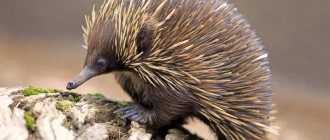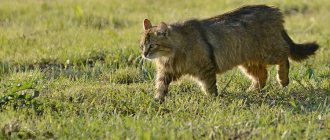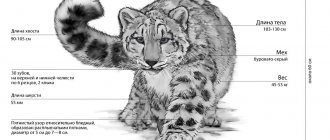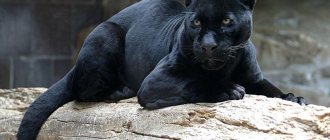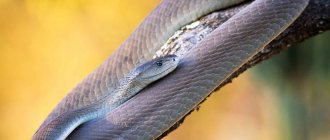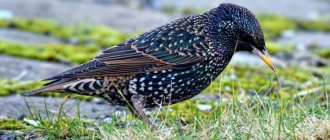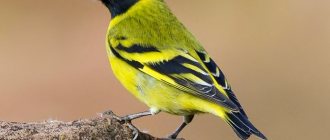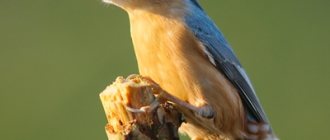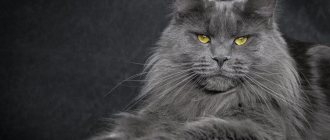One of the most beautiful felines are ocelots - cats that look like small leopards. These are wild animals whose unusual appearance has always attracted attention to them, but they still remain a little studied species.
Ocelots are one of the most beautiful felines.
The history of the origin of the ocelot wild cat is unknown. Some scholars believe that the word "ocelot" has Latin roots and means "like a leopard", others say that it refers to the dialect of the ancient Aztecs, who gave the word the meaning of "field tiger". However, these wild predators do not live in open areas, but in the American jungle. The species is known for its nocturnal lifestyle, so meeting its representatives is not so easy.
Description
The ocelot is the largest member of the genus of South American or tiger cats (Leopardus).
Their weight ranges from 8.5 to 16 kg, body length 65-97 cm. Males are much larger than females. The coat is shorter, thicker and coarser than that of its close relative, the long-tailed cat, or margay (Leopardus wiedii). The underbelly is light-colored, and the rest of the body varies in color from off-white to yellowish-brown to reddish-gray. Coloration varies depending on the habitat: ocelots in arid areas with shrubby vegetation have a lighter coat than individuals living in tropical forests. It is very rare to have a completely black coat color. Typically, ocelots have dark stripes, spots, or rosettes located around the brighter areas of their coat. The ocelot has two black stripes on its cheeks, its ears are black with a yellow spot in the center, and one or two dark transverse lines run along the inside of its legs. The shape of the muzzle is very diverse, making it easy to distinguish individual individuals. The tail is long with black rings, and the paws are large relative to the size of the body, so in Spanish, the ocelot is called “manigordo”, which translates as large feet. In addition, the front legs are wider than the hind legs. Like other members of the felid suborder, ocelots do not have a third molar. The muzzle is concave, dental formula: 3/3, 1/1, 3/2, 1/1, about 30 teeth in total. The ocelot's basal metabolic rate is approximately 0.298 cubic centimeters of oxygen per hour. The ocelot is often confused with its related species, the oncilla and the long-tailed cat. The article “Tiger cats: ocelot, margay, oncilla, and their comparative characteristics” describes the differences between these 3 species. The following 10 subspecies of ocelot are recognized:
- L.p. aequatorialis - found locally in Costa Rica. Synonyms: L. p. mearnsi and L. p. minimalis;
- L.p. albescens - lives in Texas. Synonyms: L. p. limitis and L. p. ludoviciana;
- L.p. melanura - Guyana. Synonyms: L. p. maripensis and L. p. tumatumari;
- L.p. mitis - Paraguay. Synonyms: L. p. armillatus, L. p. brasiliensis, L. p. chibi-gouazou, L. p. chibiguazu, L. p. hamiltonii, L. p. maracaya and L. p. smithii;
- L.p. nelsoni - Mexico;
- L. p. pardalis - Mexico. Synonyms: L. p. canescens, L. p. griffithii, L. p. griseus, L. p. ocelot and L. p. pictus.
- L. p. pseudopardalis - Colombia. Synonym: L. p. sanctaemartae.
- L.p. pusaea - coastal areas of Ecuador;
- L.p. sonoriensis - Mexico;
- L.p. steinbachi - Bolivia.
Habitat
Pygmy leopards are found in a variety of habitats, including tropical forests, savannas, scrublands, grasslands, mangroves and swamps. They typically live at altitudes below 1,200 meters, but sometimes live at altitudes of up to 3,800 meters above sea level. The main requirement for the habitat is dense vegetation cover. Ocelots appear in open areas only in cloudy weather or at night, when the new moon appears.
Reproduction
Ocelots are solitary animals with a polygynous breeding system. The home range of one male overlaps the ranges of several females. During estrus, females attract potential mates by emitting a loud howl similar to that of domestic cats. After pairing, ocelots copulate 5 to 10 times a day. The probability of conception during the period of estrus, which lasts about 5 days, is 60%. The average duration of estrus is about 4.63 days.
If mating is successful, the pregnant female creates a den in dense thickets where birth occurs. Pregnancy lasts 79-85 days. Litter size is 1-3 kittens, with an average of 1.63 kittens/litter. Cubs are born weighing from 200 to 340 grams. As a rule, the female gives birth to offspring once every 2 years.
Ocelot kittens are weaned from their mother's milk at 6 weeks and reach adult size at approximately 8-10 months of age. Sexual maturity in females occurs at 18-22 months and they are able to reproduce up to 13 years. Males become sexually mature at 15 months; however, spermatogenesis typically occurs around 30 months. Evidence suggests that male sexual maturation is closely related to the acquisition of a territory.
Females alone provide parental care to the offspring. Kittens begin to watch their mother during the hunt a few months after birth. Independence occurs at approximately 1 year of age, after which young ocelots must find their own territories.
Characteristics of the Ocicat
Although there is some resemblance to the ocelot, the character of the Ocicat domestic cat certainly cannot be called wild. The talkativeness of cats is especially noticeable - they are great lovers of sweet chatter with their owner or mistress. In this way, the owner is given important information about what the cat wants.
The breed has so much energy that it seems there is a hidden source somewhere. A cat can play for a long time and with pleasure. Together with innate fearlessness and curiosity, this gives the pet a desire to explore the world around him with the tirelessness of a pioneer.
Often your pet can be found on the very top shelves. Kitties love to jump, as well as climb cabinets or trees.
But without owners, an animal cannot feel happy. Communication is the basis of their excellent well-being. Loneliness in such cats even causes aggression that is unusual for them.
The Ocicat kitten has been monogamous since childhood. He will immediately notice a “favorite” in the family and become very attached to him. No, you don’t have to worry that other household members will be out of work: there will be enough attention for everyone. The spotted friend is friendly, loves to be petted and is always ready to play with a ball or small toys.
Moving with such a pet is not scary; he will easily survive the change of place and the journey. An Ocicat kitten will show curiosity towards guests, and an adult cat will also show cordiality. The animal is non-conflict from birth, one might even say it is a kind-hearted family companion.
Relations with household members are going well. For the older generations, the cat will become an interlocutor and listener, for the little ones - a companion in games and hooliganism.
If you don't respond to the cat's attention, he will be sad. But in a fit of cat love, the pet can even slightly claw, so great is the power of the Ocicat’s feelings!
If there is already an animal in the house, when a small Ocicat appears there, great. And when, on the contrary, a new animal is brought into the house, then you will have to gradually establish relationships between the animals, the kitty is a big owner!
Raising and training a pet
The Ocicat cat is smart and usually has no problems with training. You should be prepared for the fact that the smart kitty will soon open doors and drawers with the press of a handle!
The cat remembers commands and its name quickly. You don't need to invest a lot of time and effort into training.
Nutrition
The ocelot is a highly skilled hunter. These cats track prey by scent and most of their attacks are successful. Once the prey is captured, they kill it and eat it on the spot, hiding the unfinished remains. Like other felines, ocelots are well adapted to their carnivorous diet: with the help of their teeth, they tear meat from their prey, and thanks to strong digestive enzymes, they can digest it.
The ocelot's diet consists of 65-66% small rodents, 12-18% reptiles, 6-10% medium-sized mammals, 4-11% birds, and 2-7% crustaceans and fish. Their main prey are nocturnal species, including: reed hamsters (Zygodontomys), bristly rats (Echimyidae), agoutis (Dasyprocta), opossums (Didelphimorphia), and armadillos (Cingulata). Although most prey weighs less than 1 - 3% of their body weight, ocelots also consume larger prey, including four-toed anteaters (Tamandua tetradactyla), greater mazes (Mazama americana), common squirrel monkeys (Saimiri sciureus) and land monkeys. turtles (Testudinidae).
Their prey species are primarily ground-dwelling, and cats may cover large carcasses with debris for later consumption. Ocelots are generalists, and their diet changes depending on the availability of prey.
In the seasonally flooded savannas of Venezuela, these cats feed exclusively on land crabs, which are found in abundance during the rainy season. Ocelots are good swimmers and feed on aquatic and semi-aquatic prey throughout the year.
Purchasing an Ocelot kitten, price
An ocelot is a very expensive acquisition, both in terms of the cost of the purchase itself (15-20 thousand dollars) and in terms of the conditions of full maintenance.
In addition, you should buy an Ocelot for home keeping only in specialized nurseries, which are found all over the world, including in Russia and Ukraine. If the animal does not have a complete set of necessary documents, the animal, according to the new laws, is subject to seizure by government agencies, and the owner will suffer administrative punishment.
Behavior
Ocelots are nocturnal. These strongly built cats are solitary and territorial. They are active 12-14 hours a day. Ocelots rest during the day on thorny piles of branches and vines, or among the roots of large trees. Although they tend to be more active at night, sometimes during the rainy season (especially on cloudy days) hunting occurs during the day.
They spend most of their time slowly patrolling their home range and often search for prey. Researchers have found that these cats check their territories every two to four days. Males typically travel twice as far as females due to their high energy requirements, as well as the need to test females for readiness to breed within their range.
Home range
Their home ranges range from 2 to 31 km², depending on their habitat. The ranges of males are larger than those of females and do not overlap with other males. However, as in many other mammal species, male territories tend to overlap with the ranges of several females. The population density of the species averages 4 individuals for every 5 km² in lowland tropical forests, and from 2 to 5 individuals for every 5 km² in more open areas.
Feeding
Adult domestic ocelots eat almost the same food as in the wild. The basis of the diet is raw meat - game, beef, chicken, feed mice. Periodically, the diet is expanded with raw eggs, fish, and high-quality cat food. It is forbidden to feed raw pork meat (causes Aujeszky's disease). Until the age of three, ocelots receive calcium supplements and vitamins.
Feeding regimen: one or two feedings per day according to the established schedule. Food should be at room temperature, daily volume – 300 – 500 grams (depending on the weight of the animal). Remains of food and meat must be removed.
Threats
Ocelots' beautiful fur is the reason why these cats have been one of the most heavily exploited small cat species. Between 1960 and 1970, more than 200,000 individuals were killed annually for the international fur trade. Commercial hunting has decreased significantly due to legal protection, however illegal trade still persists and the species is also in demand as a pet. Ocelots are sometimes killed in retaliation for attacks on poultry. However, the main threat to this species is considered to be habitat loss associated with deforestation for cattle ranching and agriculture.
Despite these threats, the ocelot remains the most common species of small cat in much of its range, reaching higher densities than smaller species such as the margay, and ocelots are even believed to negatively influence their small relatives. However, the low reproductive rate of ocelots, combined with the need for dense habitat and abundant small prey, may be contributing to population decline.
Role in the ecosystem
Ocelots have a significant impact on their environment as predators. Although they feed primarily on terrestrial vertebrates, ocelots are opportunists and prey on many species of animals. They sometimes serve as prey for large predators (such as the jaguar (Panthera Onca)) and host numerous parasites.
Parasites:
- Paragonimus;
- Taeniidae;
- Strongylides;
- Toxocara feline;
- Capillaria;
- Spiruridae;
- Aelurostrongylus;
- Oncicola;
- Hammondia pardalis;
- Isospora.
Economic significance for humans
Positive
From the early 1960s to the mid-1980s, there was a high demand for the fur of these spotted cats in Western society. At that time, an ocelot fur coat could sell for $40,000 (US) in western Germany. Ocelots were also popular as exotic pets, fetching up to $800 per individual. In 1975, following the signing of the Convention on International Trade in Endangered Species of Wild Fauna and Flora (CITES), international trade in ocelots and their by-products (such as fur) became illegal in most countries. However, it is still possible to buy ocelots illegally at Managua International Airport in Nicaragua or on the black market.
Ocelots may be beneficial to humans by controlling the population of rodents, which are considered agricultural pests.
Negative
These cats can kill and eat poultry.
Population and species status
The ocelot is listed as a species of least concern on the International Red Book. Currently, the total number of animals in the world is estimated at 40,000 individuals. Stable populations are observed in Argentina, the Amazon, Colombia, Venezuela and the Andes. In northern Mexico and Texas, animal numbers have declined significantly in recent years due to human expansion.
Hunting for the predator is prohibited in Argentina, Brazil, Bolivia, Costa Rica, Suriname, Uruguay, Colombia, Guatemala, Honduras, Mexico, French Guiana, USA, Trinidad and Tobago, Venezuela, Nicaragua and Panama. In Peru, hunting is permitted with restrictions. Hunting is allowed in Ecuador and El Salvador.


